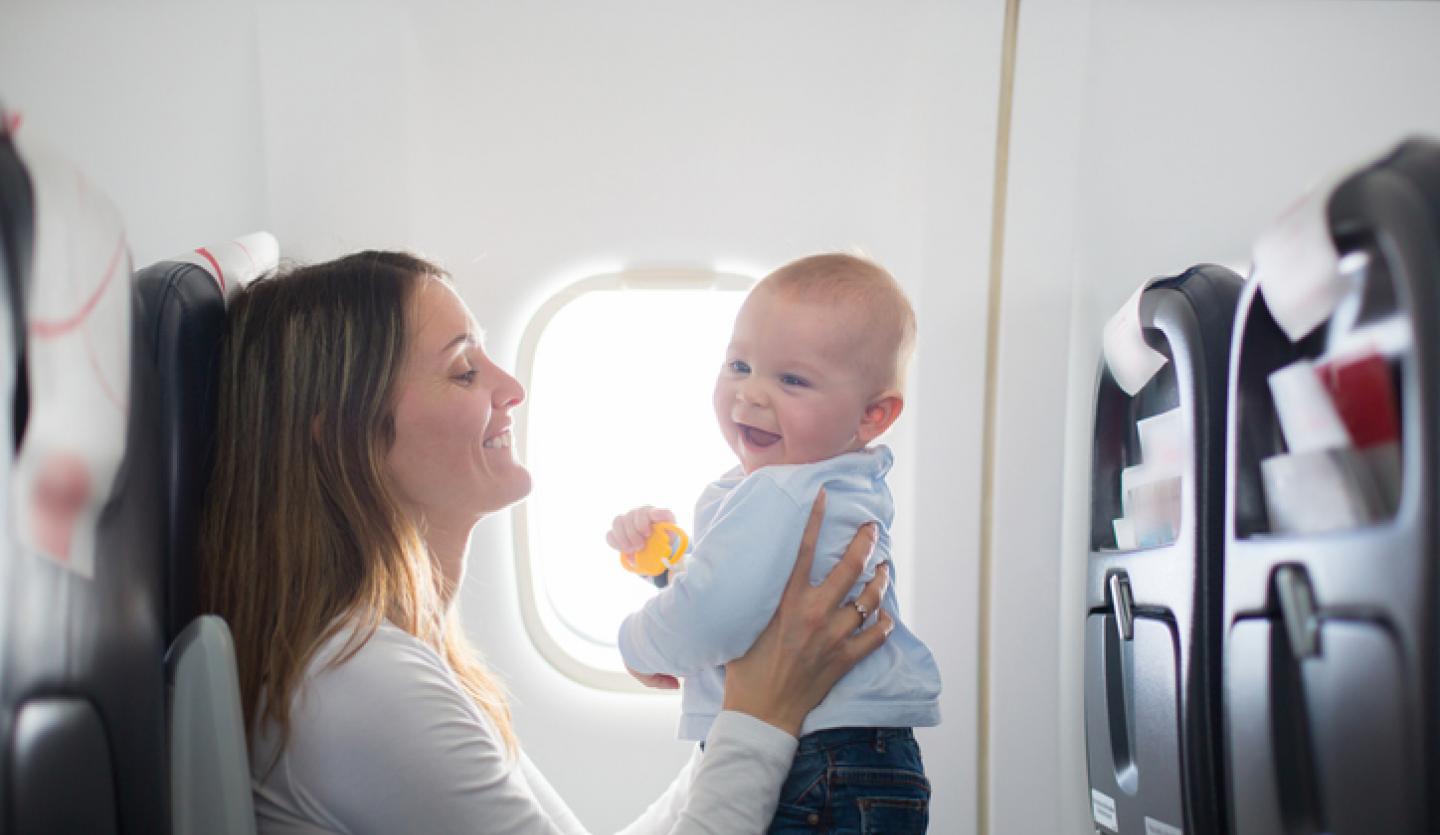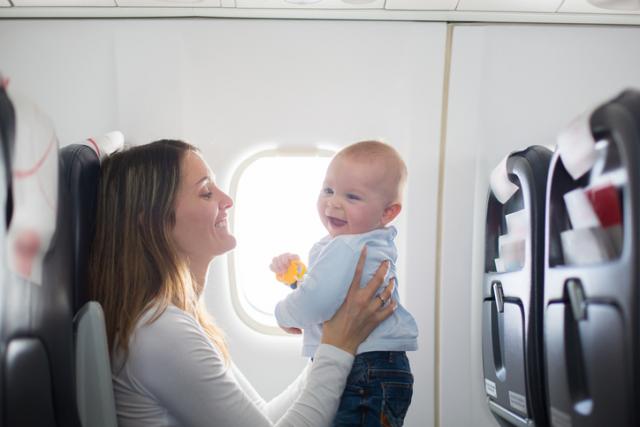Vacation is exciting and often involves flying to visit relatives, friends or just a fun family get-away. But flying can be stressful, especially with a baby. We’ve all experienced that crying baby and those poor stressed-out parents. Some planning and these helpful tips can ease some of the stress and make the flight smoother for everyone.
Car Seats
The Federal Aviation Administration (FAA) does not require the purchase of an airline ticket for any child younger than the age of two; however, the American Academy of Pediatrics (AAP) strongly urges that you secure your child in a Child Restraint System (CRS) for the duration of your flight.
A CRS protects your baby in the event of turbulence or an emergency. You may not be able to protect your baby in your arms. It will also give you space and a free lap to relax. Also, some babies sleep and behave better in their car seat than when held. Make sure your car seat is approved for use on airplanes. The label should read: "This restraint is certified for use in motor vehicles and aircraft."
If you do not buy a ticket for your child then ask if your airline will allow you to use an empty seat. If your airline's policy allows this then avoid the busiest days and times to increase the likelihood of finding an empty seat next to you.
The AAP recommends that the safest way for your baby to fly is in a child safety restraint, which is an FAA-approved car seat or airplane harness device approved for your child's age and size installed with the airplane's seat belt.
- Lap babies (under age 2) fly free on domestic flights, usually one per paying adult. You may need to present proof of age. If you haven't bought a ticket for your child then ask if your airline will allow you to use an empty seat for your CRS. If they allow this then avoid the busiest days and times to increase the likelihood of finding an empty seat next to you. Many parents like the bulkhead seat since there is more room to move around. (But less room for storage.)
- Ask your airline for a discounted fare for your baby. Many will offer discounted rates since buying a ticket for your child is the only way to guarantee that you will be able to use a CRS.
- Car seats should be placed in a window or middle seat so it will not block the aisle. Do not place a CRS in an exit row.
- Pack a bag of toys and snacks to keep your child occupied during the flight.
- Always use a CRS when driving to and from the airport.
Questions for the Airlines
Calling the airlines in advance can help you plan and avoid problems later. Some questions to ask:
- Are bassinets available on the flight? When should I reserve one? Bassinets are only available for lap babies and can only be used in bulkhead rows.
- Do all of your rows have extra oxygen masks? If not then can you seat us in a row that does? This is important to ask if you're traveling with a child who doesn't have their own seat.
- Do you allow pre-boarding for families with small children? If so then will there be a pre-boarding announcement? Or do we have to ask at the gate?
- Do lap babies get a baggage allowance?
- Does a car seat count as a carry-on? Does it count against my baggage allowance if I have to check it at the gate?
- Can we bring our stroller on board? Will it count as a carry-on? If not then you can check your collapsible stroller when you board and pick it up as you exit the plane.
- Do you have diaper-changing facilities on the aircraft? Most large airplanes have one restroom with a changing table.
- Can you warm my baby's bottle during the flight?
- Do you offer children's meals? What's included? How far in advance should I order one?
- Can my spouse or loved one get security clearance to accompany me to the departure gate if I need help?
- Do you offer assistance with maneuvering through the terminal when making connecting flights? How can I arrange for that? Carrying a CRS, a child and luggage through a busy airport can be challenging.
Crying
Let me reassure you by saying that many babies are not affected at all by the changes in cabin pressure that occur during take off and as you make your descent. But these soothing techniques may help if your baby becomes uncomfortable.
- Check the usual suspects. Is your baby hungry, wet or dirty, cold or warm, bored? If it's bright then try closing the window shade. If your baby is bored then show them the view outside the window or in the pages of the airline's magazine. Play with a toy.
- Offer your baby the breast, a bottle or pacifier during the times when the pressure changes in the cabin are likely to be greatest during takeoff and initial descent. The pressure change is typically most noticeable as much as a half hour or more before landing. Sucking and swallowing helps relieve the pressure in your baby’s ear. (Just as chewing gum and yawning does for us.)
- If sucking doesn't help and your baby seems to be bothered then stay calm and try rubbing their ears and singing a soothing song. Even if you find that nothing works to calm them down, remind yourself that you've done everything you can and that most babies who have difficulty with ear pain on airplanes tend to outgrow it. Also, most people are sympathetic and you’re likely to never see them again.
- If your baby has a cold or ear infection then discuss with your pediatrician if you should give an infant pain reliever. Decongestants are not recommended for use in infants.
- Airplane cabin noise levels can range anywhere from 60 decibels to as high as 100 decibels and tend to be louder during takeoff. Using cotton balls or small earplugs may help to decrease the decibel level your baby is exposed to, and as a result, make it easier for them to sleep or relax.
Additional Tips
- Dress yourself and your child in easy on/off layers so that you are prepared for whatever in-flight conditions you may find. Elastic-waist pants, zip-up outfits or easy-snap crotches are far easier than tights or button-up-the-back onesies when it comes to diaper changing—especially when faced with doing it in cramped quarters.
- Try to fit everything you need into your carry on. Supplies you may want to carry with you include diapering supplies, change of clothing, a favorite blanket or stuffed animal, snacks, tissues or paper towels.
Flying with a baby can be complicated. But with a little preparation and planning it will be a wonderful, exciting experience and the start of a lifetime of memories.
Additional articles of interest from the American Academy of Pediatrics:
Call (866) MY-LI-DOC (866-695-4362) to find a Catholic Health physician near you.



